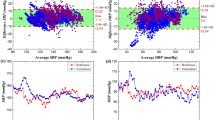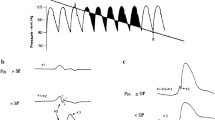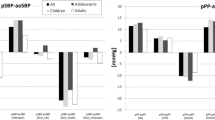Abstract
In the present study, we investigated the relationship between blood pressure (BP) and pulse transit time (PTT) and evaluated the accuracy of the PTT-based cuffless BP estimation on 14 normotensive subjects. Least-squares regression was used to estimate BP in the first test and a repeatability test carried out half year later. BP in the repeatability test was also estimated using the regression coefficients in the first test. The results illustrated that in the first and repeatability tests (1) arterial BP increased and PTT decreased acutely after the exercises and (2) systolic BP was highly correlated with PTT. In the repeatability test, the estimation differences from the references were 0.0 ± 5.3 mmHg and 0.0 ± 2.9 mmHg for systolic and diastolic BPs respectively using least-squares regression. However, the estimation differences increased to 1.4 ± 10.2 mmHg and 2.1 ± 7.3 mmHg for systolic and diastolic BPs, respectively when the regression coefficients in the first test were used for prediction. In summary, reasonable BP estimations were given in the first and repeatability tests but not using the regression coefficients obtained 6 months ago for some subjects.






Similar content being viewed by others
References
Allen RA, Schneider J, Davidson DM, Winchester MA, Taylor CB. The covariation of blood pressure and pulse transit time in hypertensive patients. Psychophysiology. 1981;18:301–5.
Brock J, Piston D, Stradling J. Use of pulse transit time as a measure of changes in inspiratory effort. J Ambul Monit. 1993;6:195–302.
Ezzati M, Lopez AD, Rodgers A, Murray CJL. Comparative quantification of health risks: global and regional burden of disease attributable to selected major risk factors. Geneva: World Health Organization; 2004.
Foo JYA. Pulse transit time in paediatric respiratory sleep studies. Med Eng Phys. 2007;29:17–25.
Geddes LA, Voelz MH, Babbs CF, Bourland JD, Tacker WA. Pulse transit time as an indicator of arterial blood pressure. Psychophysiology. 1981;18:71–4.
Hughes DJ, Babbs CF, Geddes LA. Measurements of Young’s modulus of elasticity of the canine aorta with ultrasound. Ultrasound Imaging. 1979;1:356–67.
Kearney PM, Whelton M, Reynolds K, Muntner P, Whelton PK, He J. Global burden of hypertension: analysis of worldwide data. Lancet. 2005;365:217–23.
Korteweg DJ. Ueber die fortpflanzunggesgeschwingdigkeit des schalles in elastischen rohren. Ann Physik Chemie. 1878;5:525–42.
Lane JD, Greenstadt L, Shapiro D. Pulse transit time and blood pressure: an intensive analysis. Psychophysiology. 1983;20:45–9.
Laurent S, Boutougrie P, Asmar R, Gautier I, Laloux B, Guize L, et al. Aortic stiffness is an independent predictor of all-cause and cardiovascular mortality in hypertensive patients. Hypertension. 2001;37:1236–41.
Muehlsteff J, Aubert XL, Schuett M. Cuffless estimation of systolic blood pressure for short effort bicycle tests: the prominent role of the pre-ejection period. Proceedings of the 28th annual conference of IEEE-EMBC 2006.
Newlin DB. Relationships of pulse transmission times to pre-ejection period and blood pressure. Psychophysiology. 1981;18:316–21.
Ochiai R, Takeda J, Hosaka H, Sogo Y, Tanaka R, Soma T. The relationship between modified pulse wave transit time an cardiovascular changes in isoflurane anesthetized dogs. J Clin Monit Comput. 1999;15:493–501.
Pan RLC, Li JKL. Noninvasive parametric evaluation of stress effects on cardiovascular function. Cardiovasc Eng. 2007;7:74–80.
Pitson D, Chhina N, Knijn S, Van Herwaaden M, Stradling J. Changes in pulse transit time and pulse rate as markers of arousal from sleep in normal subjects. Clin Sci (Lond). 1994;87:269–73.
Pitson DJ, Sandell A, Van den Hout R, Stradling JR. Use of pulse transit time as a measure of inspiratory effort in patients with obstructive sleep apnoea. Eur Respir J. 1995;8:1669–74.
Pollak MH, Obrist PA. Aortic-radial pulse transit time and ECG Q-wave to radial pulse wave interval as indices of beat-by-beat blood pressure change. Psychophysiology. 1983;20:21–8.
Poon CCY, Zhang YT. Cuff-less and noninvasive measurements of arterial blood pressure by pulse transit time. Proceedings of the 27th annual conference of IEEE-EMBC 2005.
Preventing chronic diseases: a vital investment. Geneva: World Health Organization; 2005.
Smith RP, Argod J, Pépin JL, Lévy PA. Pulse transit time: an appraisal of potential clinical applications. Thorax. 1999;54:452–7.
Teng XF, Poon CCY, Zhang YT. Study on the effect of contacting force on pulse transit time. Proceedings of the 2nd IEEE/EMBS International Summer School and Symposium on Medical Devices and Biosensors 2004.
Teng XF, Zhang YT. The effect of applied sensor contact force on pulse transit time. Physiol Meas. 2006;27:675–84.
Teng XF, Zhang YT. Theoretical study on the effect of sensor contact force on pulse transit time. IEEE Trans Biomed Eng. 2007;54:1490–8.
Wilkinson IB, Fuchs SA, Jansen IM, Spratt JC, Murray GD, Cockcroft JR, et al. Repeatability of pulse wave velocity and augmentation index measured by pulse wave analysis. J Hypertens. 1998;16:2079–84.
Wong MYM, Zhang YT. The relationship between pulse transit time and systolic blood pressure on individual subjects after exercises. Proceedings of Transdisciplinary Conference on Distributed Diagnosis and Home Healthcare 2006.
Wong YM, Zhang YT. The effects of exercises on the relationship between pulse transit time and arterial blood pressure. Proceedings of the 27th annual conference of IEEE-EMBC 2005.
Yu HY, Peng HH, Wang JL, Wen CY, Tseng WY. Quantification of pulse wave velocity of the descending aorta using axial velocity profiles from phase-contrast magnetic resonance imaging. Magn Reson Med. 2006;56:876–83.
Zhang XY, Zhang YT. The effect of local mild cold exposure on pulse transit time. Physiol Meas. 2006;27:649–60.
Zong W, Moody GB, Mark RG. Effects of vasoactive drugs on the relationship between ECG- pulse wave delay time and arterial blood pressure in ICU patients. Comput Cardiol. 1998;25:673–6.
Acknowledgments
This work is supported by the Hong Kong Innovation and Technology Fund. The authors would like to acknowledge Golden Meditech Company Ltd, Bird International Ltd, and Bright Steps Corporation for their supports to the study.
Author information
Authors and Affiliations
Corresponding author
Rights and permissions
About this article
Cite this article
Wong, M.YM., Poon, C.CY. & Zhang, YT. An Evaluation of the Cuffless Blood Pressure Estimation Based on Pulse Transit Time Technique: a Half Year Study on Normotensive Subjects. Cardiovasc Eng 9, 32–38 (2009). https://doi.org/10.1007/s10558-009-9070-7
Published:
Issue Date:
DOI: https://doi.org/10.1007/s10558-009-9070-7




